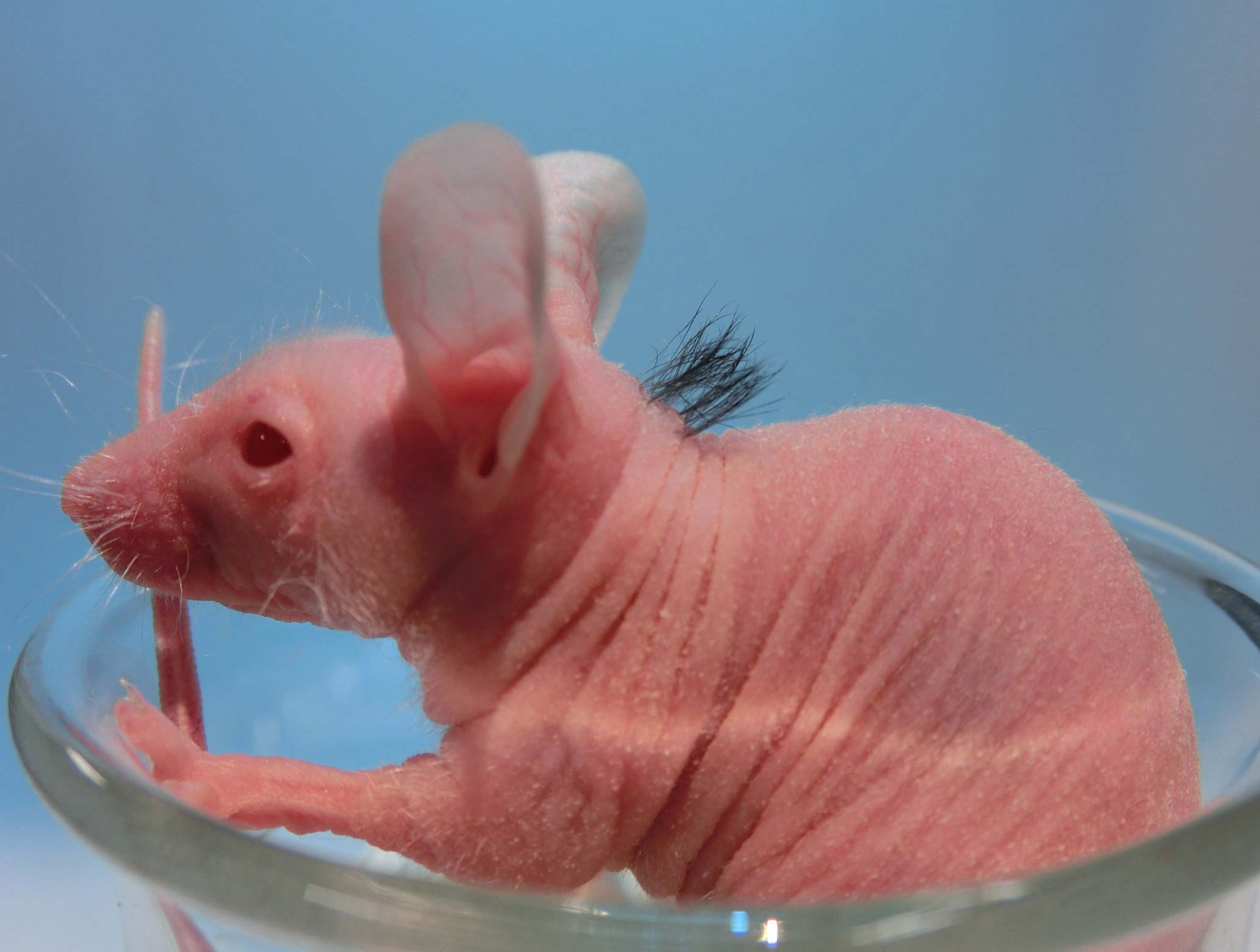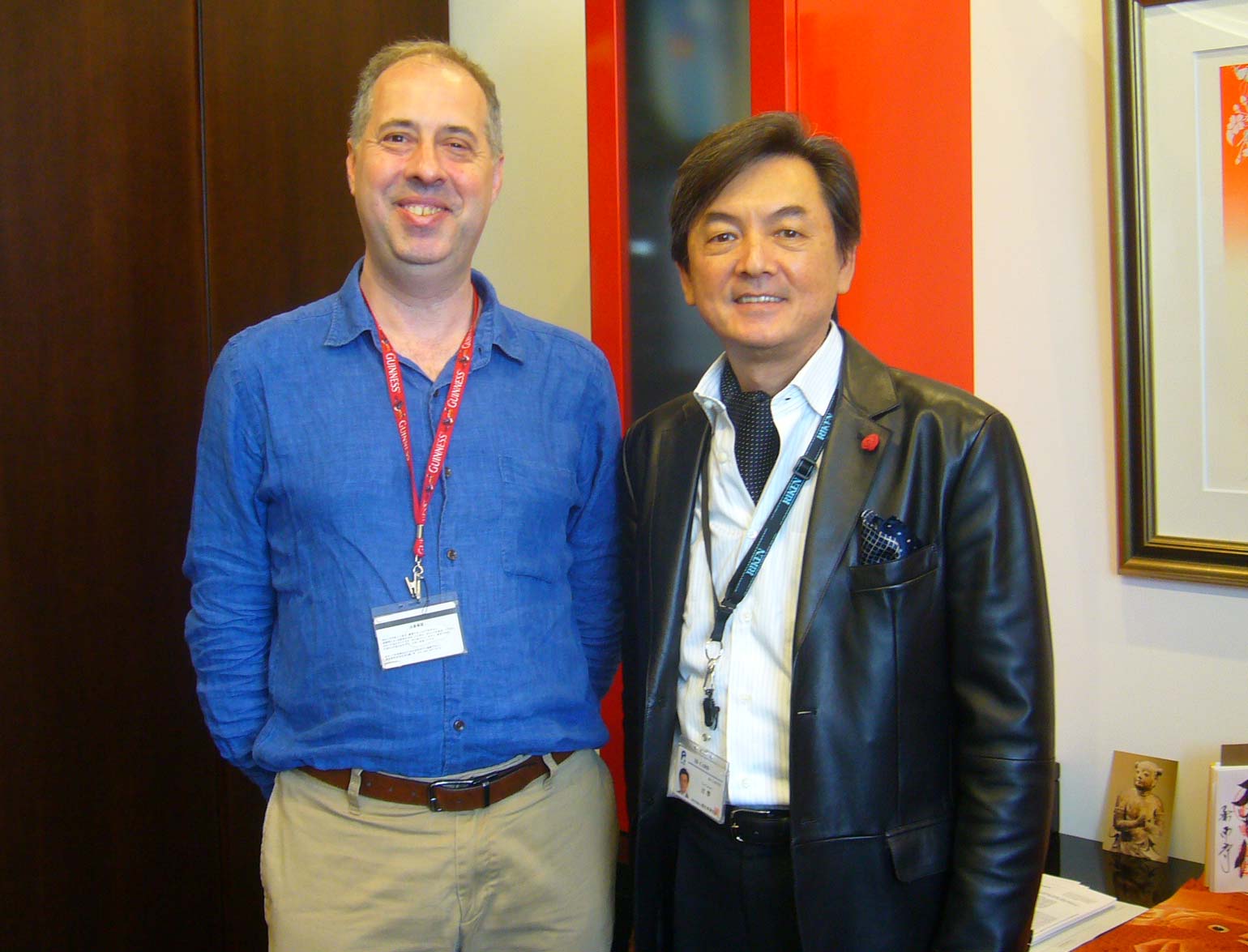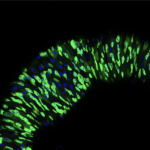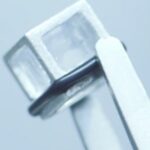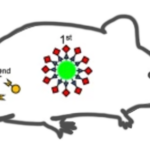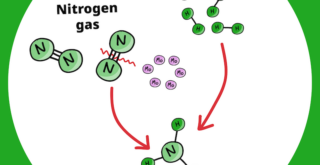What made you decide to become a scientist?
When I was young, I wanted to become a doctor. It wasn’t that there were any doctors in my family, but rather that I was impressed by a book written by the famous Japanese biologist Tokindo Okada, and I thought that going into medicine would be a way of helping people. The book dealt with the possibility of creating life in a test tube. I really didn’t like studying, however. I never understood the merit of learning about what somebody else had already made, and rather wanted to make things myself. For that reason I decided to become a researcher rather than a doctor.
So after getting my Ph.D., I began working for [itg-tooltip tooltip-content=”<p><strong>JT </strong>= Japan Tobaco company</p>”]JT[/itg-tooltip] as a researcher in stem cell medicine, which has become known as regenerative medicine. The idea we had was to take hemopoietic stem cells, which leukemia patients require, and create a bank by culturing different cells. I did that for seven years, and while I enjoyed it, I had always thought that someday I would like to have my own lab, I applied for positions at universities, and found a position at Tokyo University of Science with a lab doing organ regeneration. I enjoyed that work, but at the same time felt that I wanted to be in a place where it would be easier not just to do academic research but where I could translate my research into applications. That is how I got to RIKEN.
Could you describe the research that you are doing?
The area we work in is regenerative medicine. Generally speaking there are three generations of regenerative medicine. The first was stem cell therapy, where individual stem cells are injected into a patient’s body so that they can differentiate into somatic cells that can replace damaged cells. The second generation is where a uniform tissue is created, made up of identical cells, and then transplanted into the patient’s body. This is tissue engineering. So you might have a sheet made up of a particular type of cell such as epidermis, cornea, or cardiac muscle. Then the third generation, which is my focus, is the ability to create a three-dimensional organ made up of different types of cells which can then be transplanted, in what we call organ regeneration. It is obviously more complicated to do this, but I felt some time ago that looking toward the future, this would be the way to go. So I decided to focus my efforts in this area, thinking about what would be happening a decade later.
How long does it require to rebuild an organ?
If you depend on nature, it would take a year or two years, since the same process that creates a baby’s body is being used. The tissue engineers, however, thought that you could do it faster by using a scaffolding and then growing individual cells. So we are trying to understand and use the same phenomenon that takes place in the fetus. It does take longer, but you get a complete organ that can connect to other parts of the body.
At [itg-tooltip tooltip-content=”<p><strong>CDB</strong> = RIKEN Center for Developmental Biology</p>”]CDB[/itg-tooltip] there is another group doing work in organogenesis, which was previously led by Yoshiki Sasai. Is there a difference between your approaches?
Actually, we are working toward the same end, but we are working with different parts of the body. Basically, the other group is working with the body above the nose—meaning the brain, eyes, and the central nervous system—whereas I am working on the body from the nose down. There is a fundamental difference between the two, as brain tissue derives from interactions within the epithelium, whereas the rest of the body derives from interactions between epithelial and mesenchymal layers. So it is more natural and easier to replicate the growth of nerves, and they are easier to create. For most organs the epithelial and mesenchymal cells form an organ germ that can then become an organ. In 2007, we found a way to manipulate the interactions between these two layers designated as the Organ Germ Method. That was the beginning of my work.
It was fascinating for me to learn that the work of Alan Turing—a mathematician who did fundamental work for the development of computing—has a major influence on organ engineering. Did that influence you?
Yes, it certainly did. Alan Turing proposed that the growth or organisms was regulated by waves of activator and inhibitor stimulation, in what is called the reaction diffusion model, and my work is fundamentally based on his ideas, based on the interactions between the epithelial and mesenchymal layers. We find, for instance, that when we are growing hair follicles, the spacing between the follicles is governed by the mathematics of it. It’s due to his ideas that we were able to achieve what they did. Biological phenomena are governed by mathematics.
Though I’m not a religious person at all, I am interested in the ideas of Pythagoras, whose philosophy was based on the idea that the creator is a mathematician, and that all of creation is governed by mathematics.
Yes, I have to say that I sympathize with that view as well. Certainly many phenomena in biology are governed by mathematics. I think that probably all of biology can be explained by math.
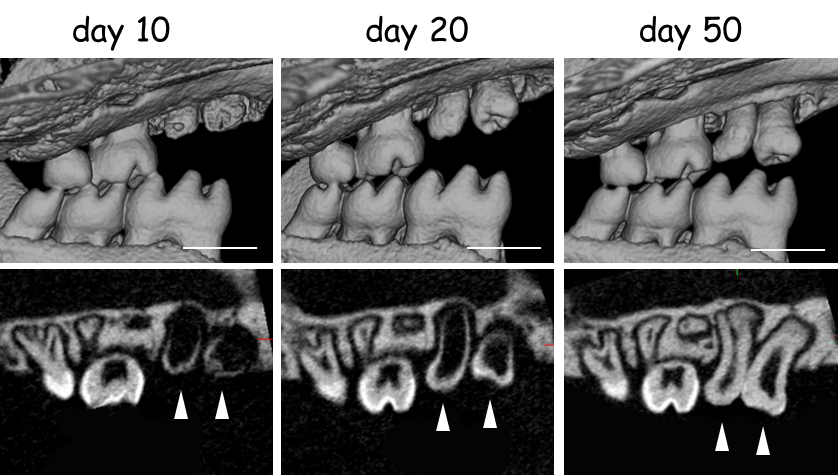
3D (top) and cross-sectional (bottom) CT images of tooth transplants growing in the jaw. Credit RIKEN
What technologies in particular do you think are promising? When we think of regenerative medicine we usually think of growing hearts to help heart failure patients, for example.
We are focusing our efforts on organs that are not essential for life. It is a good place to start, because you can experiment without causing a death if the treatment is unsuccessful. So we feel it is better to start there and then move on to vital organs if the technology turns out to be feasible.
In practice, what that means is that we are focusing on teeth and hair. As you can imagine, these are both major markets. Almost everybody needs some replacement teeth as they grow older, and many men experience hair loss, so there is a big demand for regenerative medicine in this area.
Speaking of hair loss, it was recently reported that you are working with a private company to development a treatment for using regenerative medicine to regrow hair. Will this be available soon?
I think it will. We have developed technology to grow hair follicles using stem cells, as hair follicles are one of the few organs where we always have stem cells ready. We hope to be able to start clinical trials in the next few years so that the treatment can move into the clinic.
What is it that attracted you to RIKEN?
I always wanted to put my research into practice, by creating something new. It was difficult to do that with the research style of universities. At CDB, I was able to work with top-class researchers, in an environment where there were companies all around. So I felt I could do translational research to put the fruits of the 13 years I spent in university into practice. It was attractive that I could concentrate on research alone.
I was also attracted to RIKEN partly because of what I knew about Masatoshi Okochi, who was the third president of the organization. He led RIKEN from 1921 to 1946. One of the important things he did was to establish subsidiary companies which sold products based on technologies developed at RIKEN. So instead of receiving money from the government, they used their inventions to finance research. In fact, at that time it was possible to use income derived from discoveries made in chemistry to finance things like the cyclotrons that Dr. Yoshio Nishina was developing. I thought it was a great idea, and my own vision is similar to that. I would like to see RIKEN go back to the pattern that President Okochi created.
Following that example, do you yourself have joint research with industry?
Yes, I have relationships with 11 companies at present. Some are involved in regenerative medicine, and some are working in the area of healthcare. The reason that healthcare companies have an interest in our work is that unlike in the United States, the healthcare system in Japan is capped, and actually it is in real danger of bankruptcy. So it is important to try to keep people healthy so that we can avoid unnecessary expenses. In my lab now, I have 15 researchers and technical staff from within RIKEN, but I have another 15 researchers who have been assigned here by companies.
Do you have hobbies outside of your scientific research?
Yes, I like to go fishing. I practice a special kind of fishing, which is not boat based. When I go on a trip, a boat will take me out to a small island in the sea, and drop me off in the morning. I fish all day from that island, and then in the evening they pick me up again. I like to go to Owase, in Mie Prefecture. Sometimes the islands are not much bigger than this room. I have a colleague who has done this with me for many years. His research field is chemistry, so on the way back and forth from the islands we spend the time talking about our research. We have been doing this for more than 15 years.
What kind of fish do you catch?
It’s a kind of fish called largescale blackfish, It’s a common fish in warm Asian waters, and grows up to about 60 centimeters.
What made you decide to become a scientist?
When I was young, I wanted to become a doctor. It wasn’t that there were any doctors in my family, but rather that I was impressed by a book written by the famous Japanese biologist Tokindo Okada, and I thought that going into medicine would be a way of helping people. The book dealt with the possibility of creating life in a test tube. I really didn’t like studying, however. I never understood the merit of learning about what somebody else had already made, and rather wanted to make things myself. For that reason I decided to become a researcher rather than a doctor.
So after getting my Ph.D., I began working for [itg-tooltip tooltip-content=”<p><strong>JT </strong>= Japan Tobaco company</p>”]JT[/itg-tooltip] as a researcher in stem cell medicine, which has become known as regenerative medicine. The idea we had was to take hemopoietic stem cells, which leukemia patients require, and create a bank by culturing different cells. I did that for seven years, and while I enjoyed it, I had always thought that someday I would like to have my own lab, I applied for positions at universities, and found a position at Tokyo University of Science with a lab doing organ regeneration. I enjoyed that work, but at the same time felt that I wanted to be in a place where it would be easier not just to do academic research but where I could translate my research into applications. That is how I got to RIKEN.
Could you describe the research that you are doing?
The area we work in is regenerative medicine. Generally speaking there are three generations of regenerative medicine. The first was stem cell therapy, where individual stem cells are injected into a patient’s body so that they can differentiate into somatic cells that can replace damaged cells. The second generation is where a uniform tissue is created, made up of identical cells, and then transplanted into the patient’s body. This is tissue engineering. So you might have a sheet made up of a particular type of cell such as epidermis, cornea, or cardiac muscle. Then the third generation, which is my focus, is the ability to create a three-dimensional organ made up of different types of cells which can then be transplanted, in what we call organ regeneration. It is obviously more complicated to do this, but I felt some time ago that looking toward the future, this would be the way to go. So I decided to focus my efforts in this area, thinking about what would be happening a decade later.
How long does it require to rebuild an organ?
If you depend on nature, it would take a year or two years, since the same process that creates a baby’s body is being used. The tissue engineers, however, thought that you could do it faster by using a scaffolding and then growing individual cells. So we are trying to understand and use the same phenomenon that takes place in the fetus. It does take longer, but you get a complete organ that can connect to other parts of the body.
At [itg-tooltip tooltip-content=”<p><strong>CDB</strong> = RIKEN Center for Developmental Biology</p>”]CDB[/itg-tooltip] there is another group doing work in organogenesis, which was previously led by Yoshiki Sasai. Is there a difference between your approaches?
Actually, we are working toward the same end, but we are working with different parts of the body. Basically, the other group is working with the body above the nose—meaning the brain, eyes, and the central nervous system—whereas I am working on the body from the nose down. There is a fundamental difference between the two, as brain tissue derives from interactions within the epithelium, whereas the rest of the body derives from interactions between epithelial and mesenchymal layers. So it is more natural and easier to replicate the growth of nerves, and they are easier to create. For most organs the epithelial and mesenchymal cells form an organ germ that can then become an organ. In 2007, we found a way to manipulate the interactions between these two layers designated as the Organ Germ Method. That was the beginning of my work.
It was fascinating for me to learn that the work of Alan Turing—a mathematician who did fundamental work for the development of computing—has a major influence on organ engineering. Did that influence you?
Yes, it certainly did. Alan Turing proposed that the growth or organisms was regulated by waves of activator and inhibitor stimulation, in what is called the reaction diffusion model, and my work is fundamentally based on his ideas, based on the interactions between the epithelial and mesenchymal layers. We find, for instance, that when we are growing hair follicles, the spacing between the follicles is governed by the mathematics of it. It’s due to his ideas that we were able to achieve what they did. Biological phenomena are governed by mathematics.
Though I’m not a religious person at all, I am interested in the ideas of Pythagoras, whose philosophy was based on the idea that the creator is a mathematician, and that all of creation is governed by mathematics.
Yes, I have to say that I sympathize with that view as well. Certainly many phenomena in biology are governed by mathematics. I think that probably all of biology can be explained by math.

3D (top) and cross-sectional (bottom) CT images of tooth transplants growing in the jaw. Credit RIKEN
What technologies in particular do you think are promising? When we think of regenerative medicine we usually think of growing hearts to help heart failure patients, for example.
We are focusing our efforts on organs that are not essential for life. It is a good place to start, because you can experiment without causing a death if the treatment is unsuccessful. So we feel it is better to start there and then move on to vital organs if the technology turns out to be feasible.
In practice, what that means is that we are focusing on teeth and hair. As you can imagine, these are both major markets. Almost everybody needs some replacement teeth as they grow older, and many men experience hair loss, so there is a big demand for regenerative medicine in this area.
Speaking of hair loss, it was recently reported that you are working with a private company to development a treatment for using regenerative medicine to regrow hair. Will this be available soon?
I think it will. We have developed technology to grow hair follicles using stem cells, as hair follicles are one of the few organs where we always have stem cells ready. We hope to be able to start clinical trials in the next few years so that the treatment can move into the clinic.
What is it that attracted you to RIKEN?
I always wanted to put my research into practice, by creating something new. It was difficult to do that with the research style of universities. At CDB, I was able to work with top-class researchers, in an environment where there were companies all around. So I felt I could do translational research to put the fruits of the 13 years I spent in university into practice. It was attractive that I could concentrate on research alone.
I was also attracted to RIKEN partly because of what I knew about Masatoshi Okochi, who was the third president of the organization. He led RIKEN from 1921 to 1946. One of the important things he did was to establish subsidiary companies which sold products based on technologies developed at RIKEN. So instead of receiving money from the government, they used their inventions to finance research. In fact, at that time it was possible to use income derived from discoveries made in chemistry to finance things like the cyclotrons that Dr. Yoshio Nishina was developing. I thought it was a great idea, and my own vision is similar to that. I would like to see RIKEN go back to the pattern that President Okochi created.
Following that example, do you yourself have joint research with industry?
Yes, I have relationships with 11 companies at present. Some are involved in regenerative medicine, and some are working in the area of healthcare. The reason that healthcare companies have an interest in our work is that unlike in the United States, the healthcare system in Japan is capped, and actually it is in real danger of bankruptcy. So it is important to try to keep people healthy so that we can avoid unnecessary expenses. In my lab now, I have 15 researchers and technical staff from within RIKEN, but I have another 15 researchers who have been assigned here by companies.
Do you have hobbies outside of your scientific research?
Yes, I like to go fishing. I practice a special kind of fishing, which is not boat based. When I go on a trip, a boat will take me out to a small island in the sea, and drop me off in the morning. I fish all day from that island, and then in the evening they pick me up again. I like to go to Owase, in Mie Prefecture. Sometimes the islands are not much bigger than this room. I have a colleague who has done this with me for many years. His research field is chemistry, so on the way back and forth from the islands we spend the time talking about our research. We have been doing this for more than 15 years.
What kind of fish do you catch?
It’s a kind of fish called largescale blackfish, It’s a common fish in warm Asian waters, and grows up to about 60 centimeters.

